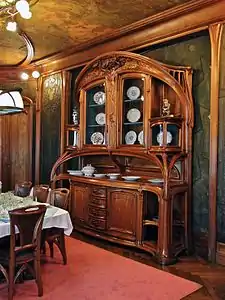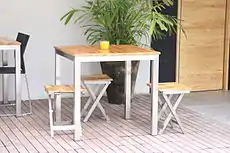Furniture
Furniture refers to movable objects intended to support various human activities such as seating (e.g., chairs, stools, and sofas), eating (tables), and sleeping (e.g., beds). Furniture is also used to hold objects at a convenient height for work (as horizontal surfaces above the ground, such as tables and desks), or to store things (e.g., cupboards and shelves). Furniture can be a product of design and is considered a form of decorative art. In addition to furniture's functional role, it can serve a symbolic or religious purpose. It can be made from many materials, including metal, plastic, and wood. Furniture can be made using a variety of woodworking joints which often reflect the local culture.
People have been using natural objects, such as tree stumps, rocks and moss, as furniture since the beginning of human civilisation. Archaeological research shows that from around 30,000 years ago, people started to construct and carve their own furniture, using wood, stone, and animal bones. Early furniture from this period is known from artwork such as a Venus figurine found in Russia, depicting the goddess on a throne. The first surviving extant furniture is in the homes of Skara Brae in Scotland, and includes cupboards, dressers and beds all constructed from stone. Complex construction techniques such as joinery began in the early dynastic period of ancient Egypt. This era saw constructed wooden pieces, including stools and tables, sometimes decorated with valuable metals or ivory. The evolution of furniture design continued in ancient Greece and ancient Rome, with thrones being commonplace as well as the klinai, multipurpose couches used for relaxing, eating, and sleeping. The furniture of the Middle Ages was usually heavy, oak, and ornamented. Furniture design expanded during the Italian Renaissance of the fourteenth and fifteenth century. The seventeenth century, in both Southern and Northern Europe, was characterized by opulent, often gilded Baroque designs. The nineteenth century is usually defined by revival styles. The first three-quarters of the twentieth century are often seen as the march towards Modernism. One unique outgrowth of post-modern furniture design is a return to natural shapes and textures.[1]
Etymology
The English word furniture is derived from the French word fourniture,[2] the noun form of fournir, which means to supply or provide.[3] Thus fourniture in French means supplies or provisions.[4] The English usage, referring specifically to household objects, is specific to that language;[5] French and other Romance languages as well as German use variants of the word meubles, which derives from Latin mobilia, meaning "moveable goods".[6]
History
Prehistory
The practice of using natural objects as rudimentary pieces of furniture likely dates to the beginning of human civilisation.[7] Early humans are likely to have used tree stumps as seats, rocks as rudimentary tables, and mossy areas for sleeping.[7] During the late palaeolithic or early neolithic period, from around 30,000 years ago, people began constructing and carving their own furniture, using wood, stone and animal bones.[8] The earliest evidence for the existence of constructed furniture is a Venus figurine found at the Gagarino site in Russia, which depicts the goddess in a sitting position, on a throne.[9] A similar statue of a seated woman was found in Catal Huyuk in Turkey, dating to between 6000 and 5500 BCE.[7] The inclusion of such a seat in the figurines implies that these were already common artefacts of that age.[9]
A range of unique stone furniture has been excavated in Skara Brae, a Neolithic village in Orkney, Scotland. The site dates from 3100–2500 BCE and due to a shortage of wood in Orkney, the people of Skara Brae were forced to build with stone, a readily available material that could be worked easily and turned into items for use within the household. Each house shows a high degree of sophistication and was equipped with an extensive assortment of stone furniture, ranging from cupboards, dressers and beds to shelves, stone seats, and limpet tanks. The stone dresser was regarded as the most important as it symbolically faces the entrance in each house and is therefore the first item seen when entering, perhaps displaying symbolic objects, including decorative artwork such as several Neolithic Carved Stone Balls also found at the site.
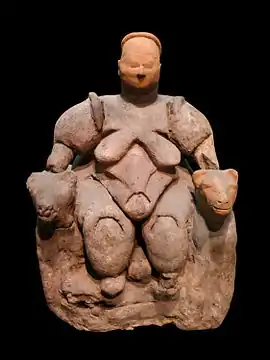 The Seated Woman of Çatalhöyük, a figurine discovered in Turkey and dated to approximately 6000 BC, is evidence that furniture existed in the neolithic.
The Seated Woman of Çatalhöyük, a figurine discovered in Turkey and dated to approximately 6000 BC, is evidence that furniture existed in the neolithic. A dresser with shelves furnish a house in Skara Brae, a settlement in what is now Scotland that was occupied from about 3180-2500 BC
A dresser with shelves furnish a house in Skara Brae, a settlement in what is now Scotland that was occupied from about 3180-2500 BC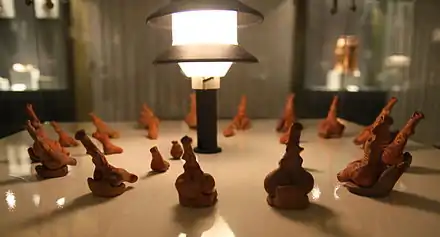 Cucuteni ritualic figurines staying on miniature chairs; 4900-4750 BC; painted ceramic; Archaeology Museum Piatra Neamț (Piatra Neamț, Romania)
Cucuteni ritualic figurines staying on miniature chairs; 4900-4750 BC; painted ceramic; Archaeology Museum Piatra Neamț (Piatra Neamț, Romania)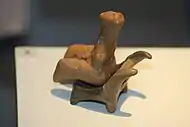 Cucuteni figurine staying on a miniature chair; 4750-4700 BC; ceramic; discoeved at Târpești (modern-day Romania); Archaeology Museum Piatra Neamț
Cucuteni figurine staying on a miniature chair; 4750-4700 BC; ceramic; discoeved at Târpești (modern-day Romania); Archaeology Museum Piatra Neamț
Antiquity
Ancient furniture has been excavated from the 8th-century BCE Phrygian tumulus, the Midas Mound, in Gordion, Turkey. Pieces found here include tables and inlaid serving stands. There are also surviving works from the 9th-8th-century BCE Assyrian palace of Nimrud. The earliest surviving carpet, the Pazyryk Carpet was discovered in a frozen tomb in Siberia and has been dated between the 6th and 3rd century BCE.
Ancient Egypt
Civilisation in ancient Egypt began with the clearance and irrigation of land along the banks of the River Nile,[10] which began in about 6000 BCE. By that time, society in the Nile Valley was already engaged in organized agriculture and the construction of large buildings.[11] At this period, Egyptians in the southwestern corner of Egypt were herding cattle and also constructing large buildings. Mortar was in use by around 4000 BCE The inhabitants of the Nile Valley and delta were self-sufficient and were raising barley and emmer (an early variety of wheat) and stored it in pits lined with reed mats.[12] They raised cattle, goats and pigs and they wove linens and baskets.[12] Evidence of furniture from the predynastic period is scarce, but samples from First Dynasty tombs indicate an already advanced use of furnishings in the houses of the age.[13]
During the dynastic period, which began in around 3200 BCE, Egyptian art developed significantly, and this included furniture design.[14] Egyptian furniture was primarily constructed using wood, but other materials were sometimes used, such as leather,[15] and pieces were often adorned with gold, silver, ivory and ebony, for decoration.[15] Wood found in Egypt was not suitable for furniture construction, so it had to be imported into the country from other places,[14] particularly Phoenicia.[16] The scarcity of wood necessitated innovation in construction techniques. The use of scarf joints to join two shorter pieces together and form a longer beam was one example of this,[17] as well as construction of veneers in which low quality cheap wood was used as the main building material, with a thin layer of expensive wood on the surface.[18]
The earliest used seating furniture in the dynastic period was the stool, which was used throughout Egyptian society, from the royal family down to ordinary citizens.[19] Various different designs were used, including stools with four vertical legs, and others with crossed splayed legs; almost all had rectangular seats, however.[19] Examples include the workman's stool, a simple three legged structure with a concave seat, designed for comfort during labour,[20] and the much more ornate folding stool, with crossed folding legs,[21] which were decorated with carved duck heads and ivory,[21] and had hinges made of bronze.[19] Full chairs were much rarer in early Egypt, being limited to only wealthy and high ranking people, and seen as a status symbol; they did not reach ordinary households until the 18th dynasty.[22] Early examples were formed by adding a straight back to a stool, while later chairs had an inclined back.[22] Other furniture types in ancient Egypt include tables, which are heavily represented in art, but almost nonexistent as preserved items – perhaps because they were placed outside tombs rather than within,[23] as well as beds and storage chests.[24][25]
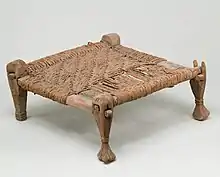 Stool with woven seat; 1991–1450 BC; wood & reed; height: 13 cm; Metropolitan Museum of Art
Stool with woven seat; 1991–1450 BC; wood & reed; height: 13 cm; Metropolitan Museum of Art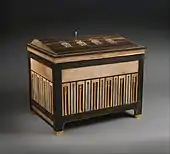 Jewelry chest of Sithathoryunet; 1887–1813 BC; ebony, ivory, gold, carnelian, blue faience and silver; height: 36.7 cm; Metropolitan Museum of Art
Jewelry chest of Sithathoryunet; 1887–1813 BC; ebony, ivory, gold, carnelian, blue faience and silver; height: 36.7 cm; Metropolitan Museum of Art.jpg.webp) Chair of Hatnefer; 1492–1473 BC; boxwood, cypress, ebony & linen cord; height: 53 cm; Metropolitan Museum of Art
Chair of Hatnefer; 1492–1473 BC; boxwood, cypress, ebony & linen cord; height: 53 cm; Metropolitan Museum of Art.jpg.webp) The Throne of Tutankhamun; 1336–1327 BC; wood covered with sheets of gold, silver, semi-precious and other stones, faience, glass and bronze; height: 1 m; Egyptian Museum (Cairo)
The Throne of Tutankhamun; 1336–1327 BC; wood covered with sheets of gold, silver, semi-precious and other stones, faience, glass and bronze; height: 1 m; Egyptian Museum (Cairo)
Ancient Greece
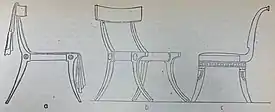
Historical knowledge of Greek furniture is derived from various sources, including literature, terracotta, sculptures, statuettes, and painted vases.[26] Some pieces survive to this day, primarily those constructed from metals, including bronze, or marble.[26] Wood was an important material in Greek furniture, both domestic and imported.[26] A common technique was to construct the main sections of the furniture with cheap solid wood, then apply a veneer using an expensive wood, such as maple or ebony.[26] Greek furniture construction also made use of dowels and tenons for joining the wooden parts of a piece together.[26] Wood was shaped by carving, steam treatment, and the lathe, and furniture is known to have been decorated with ivory, tortoise shell, glass, gold or other precious materials.[27]
The modern word “throne” is derived from the ancient Greek thronos (Greek singular: θρόνος), which was a seat designated for deities or individuals of high status or honor.[28] The colossal chryselephantine statue of Zeus at Olympia, constructed by Phidias and lost in antiquity, featured the god Zeus seated on an elaborate throne, which was decorated with gold, precious stones, ebony and ivory, according to Pausanias.[29] Other Greek seats included the klismos, an elegant Greek chair with a curved backrest and legs whose form was copied by the Romans and is now part of the vocabulary of furniture design,[30] the backless stool (diphros), which existed in most Greek homes,[31] and folding stool.[32] The kline, used from the late seventh century BCE,[33] was a multipurpose piece used as a bed, but also as a sofa and for reclining during meals.[34] It was rectangular and supported on four legs, two of which could be longer than the other, providing support for an armrest or headboard.[35] Mattresses, rugs, and blankets may have been used, but there is no evidence for sheets.[34]
In general, Greek tables were low and often appear in depictions alongside klinai.[36] The most common type of Greek table had a rectangular top supported on three legs, although numerous configurations exist, including trapezoid and circular.[37] Tables in ancient Greece were used mostly for dining purposes – in depictions of banquets, it appears as though each participant would have utilized a single table, rather than a collective use of a larger piece.[38] Tables also figured prominently in religious contexts, as indicated in vase paintings, for example, the wine vessel associated with Dionysus, dating to around 450 BCE and now housed at the Art Institute of Chicago.[39] Chests were used for storage of clothes and personal items and were usually rectangular with hinged lids.[37] Chests depicted in terracotta show elaborate patterns and design, including the Greek fret.[34]
 Foot in the form of a sphinx; circa 600 BC; bronze; overall: 27.6 x 20.3 x 16.5 cm; Metropolitan Museum of Art (New York City)
Foot in the form of a sphinx; circa 600 BC; bronze; overall: 27.6 x 20.3 x 16.5 cm; Metropolitan Museum of Art (New York City)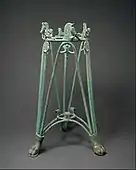 Rod tripod stand; early 6th century BC; bronze; overall: 75.2 x 44.5 cm; Metropolitan Museum of Art
Rod tripod stand; early 6th century BC; bronze; overall: 75.2 x 44.5 cm; Metropolitan Museum of Art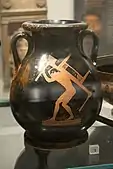 Pelike which depicts a boy carrying furniture for a symposium (drinking party), in the Ashmolean Museum (Oxford, UK)
Pelike which depicts a boy carrying furniture for a symposium (drinking party), in the Ashmolean Museum (Oxford, UK).jpg.webp) Funerary stele in which appears somebody staying on a klismos, from circa 410-400 BC, in the National Archaeological Museum (Athens, Greece)
Funerary stele in which appears somebody staying on a klismos, from circa 410-400 BC, in the National Archaeological Museum (Athens, Greece)
Ancient Rome
Roman furniture was based heavily on Greek furniture, in style and construction. Rome gradually superseded Greece as the foremost culture of Europe, leading eventually to Greece becoming a province of Rome in 146 BC. Rome thus took over production and distribution of Greek furniture, and the boundary between the two is blurred. The Romans did have some limited innovation outside of Greek influence, and styles distinctly their own.[40]
Roman furniture was constructed principally using wood, metal and stone, with marble and limestone used for outside furniture. Very little wooden furniture survives intact, but there is evidence that a variety of woods were used, including maple, citron, beech, oak, and holly. Some imported wood such as satinwood was used for decoration. The most commonly used metal was bronze, of which numerous examples have survived, for example, headrests for couches and metal stools. Similar to the Greeks, Romans used tenons, dowels, nails, and glue to join wooden pieces together, and also practised veneering.[40]
The 1738 and 1748 excavations of Herculaneum and Pompeii revealed Roman furniture, preserved in the ashes of the AD 79 eruption of Vesuvius.
_(14804265373).jpg.webp) Illustration of Roman furniture details, from 1900, very similar with Empire style furniture
Illustration of Roman furniture details, from 1900, very similar with Empire style furniture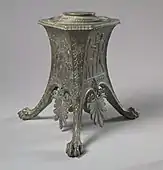 Tripod base; circa 100 BC; bronze; overall: 77 x 32.3 x 28 cm; Cleveland Museum of Art (Cleveland, Ohio, USA)
Tripod base; circa 100 BC; bronze; overall: 77 x 32.3 x 28 cm; Cleveland Museum of Art (Cleveland, Ohio, USA)_01.jpg.webp) Treasure chest with a sacrifice of Jupiter depicted on it; 1st century AD; wood, iron and bronze, with ageminature; from Pompeii; Naples National Archaeological Museum (Naples, Italy)
Treasure chest with a sacrifice of Jupiter depicted on it; 1st century AD; wood, iron and bronze, with ageminature; from Pompeii; Naples National Archaeological Museum (Naples, Italy)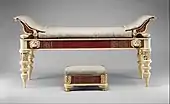 Couch and footstool with bone carvings and glass inlays; 1st–2nd century AD; wood, bone and glass; couch: 105.4 × 76.2 × 214.6 cm; Metropolitan Museum of Art (New York City)
Couch and footstool with bone carvings and glass inlays; 1st–2nd century AD; wood, bone and glass; couch: 105.4 × 76.2 × 214.6 cm; Metropolitan Museum of Art (New York City)
Middle Ages
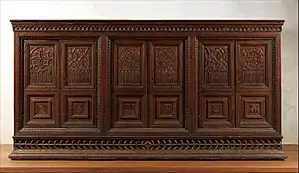
In contrast to the ancient civilisations of Egypt, Greece, and Rome, there is comparatively little evidence of furniture from the 5th to the 15th century.[41] Very few extant pieces survive, and evidence in literature is also scarce.[41] It is likely that the style of furniture prevalent in late antiquity persisted throughout the middle ages.[41] For example, a throne similar to that of Zeus is depicted in a sixth-century diptych,[41] while the Bayeux tapestry shows Edward the Confessor and Harold seated on seats similar to the Roman sella curulis.[42] The furniture of the Middle Ages was usually heavy, oak, and ornamented with carved designs.
The Hellenistic influence upon Byzantine furniture can be seen through the use of acanthus leafs, palmettes, bay and olive leaves as ornaments. Oriental influences manifest through rosettes, arabesques and the geometric stylisation of certain vegetal motifs. Christianity brings symbols in Byzantine ornamentation: the pigeon, fishes, the lamb and vines.[43] The furniture from Byzantine houses and palaces was usually luxurious, highly decorated and finely ornamented. Stone, marble, metal, wood and ivory are used. Surfaces and ornaments are gilded, painted plychrome, plated with sheets of gold, emailed in bright colors, and covered in precious stones. The variety of Byzantine furniture is pretty big: tables with square, rectangle or round top, sumptuous decorated, made of wood sometimes inlaid, with bronze, ivory or silver ornaments; chairs with high backs and with wool blankets or animal furs, with coloured pillows, and then banks and stools; wardrobes were used only for storing books; cloths and valuable objects were kept in chests, with iron locks; the form of beds imitated the roman ones, but have different designs of legs.[44]
The main ornament of Gothic furniture and all applied arts is the ogive. The geometric rosette accompanies the ogive many times, having a big variety of forms. Architectural elements are used at furniture, at the beginning with purely decorative reasons, but later as structure elements. Besides the ogive, the main ornaments are: acanthus leafs, ivy, oak leafs, haulms, clovers, fleurs-de-lis, knights with shields, heads with crowns and characters from the Bible. Chests are the main type of Gothic furniture used by the majority of the population. Usually, the locks and escutcheon of chests have also an ornamental scope, being finely made.[45]

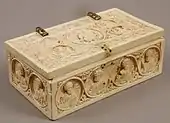 Byzantine reliquary casket with the deesis, archangels, and the twelve apostles; 950–1000; ivory with gilt-copper alloy mounts; overall (with mounts): 7.1 x 18.3 x 10.8 cm; Metropolitan Museum of Art (New York City)
Byzantine reliquary casket with the deesis, archangels, and the twelve apostles; 950–1000; ivory with gilt-copper alloy mounts; overall (with mounts): 7.1 x 18.3 x 10.8 cm; Metropolitan Museum of Art (New York City)_MET_DP273975_(cropped).jpg.webp) German Gothic coffret (Minnekästchen); circa 1325-1350; oak, inlay, tempera, wrought-iron mounts; overall: 12.1 x 27.3 x 16.5 cm; Metropolitan Museum of Art
German Gothic coffret (Minnekästchen); circa 1325-1350; oak, inlay, tempera, wrought-iron mounts; overall: 12.1 x 27.3 x 16.5 cm; Metropolitan Museum of Art Spanish Gothic paschal candlestick; circa 1450-1500; wood with paint and gilding; 195.6 × 43.8 cm; Metropolitan Museum of Art
Spanish Gothic paschal candlestick; circa 1450-1500; wood with paint and gilding; 195.6 × 43.8 cm; Metropolitan Museum of Art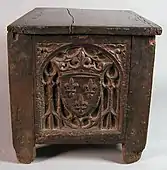 French Gothic chest; late 15th century; wood; 30.2 x 29.2 x 39.4 cm; Metropolitan Museum of Art
French Gothic chest; late 15th century; wood; 30.2 x 29.2 x 39.4 cm; Metropolitan Museum of Art
Renaissance
Along with the other arts, the Italian Renaissance of the fourteenth and fifteenth century marked a rebirth in design, often inspired by the Greco-Roman tradition. A similar explosion of design, and renaissance of culture in general occurred in Northern Europe, starting in the fifteenth century.
%252C_pair_with_1975.1.1947_MET_SLP1940-1.jpg.webp) Renaissance cassone (chest); mid 16th century; walnut, carved and partially gilded, coniferous wood; height: 73.6 cm, width: 1.7 m, depth: 63.5 cm; Metropolitan Museum of Art (New York City)
Renaissance cassone (chest); mid 16th century; walnut, carved and partially gilded, coniferous wood; height: 73.6 cm, width: 1.7 m, depth: 63.5 cm; Metropolitan Museum of Art (New York City)_MET_DP106698.jpg.webp) Renaissance cassone; circa 1550-1560; carved and partially gilded walnut; 86.4 x 181.9 x 67.3 cm; from Rome; Metropolitan Museum of Art
Renaissance cassone; circa 1550-1560; carved and partially gilded walnut; 86.4 x 181.9 x 67.3 cm; from Rome; Metropolitan Museum of Art_MET_DP105799.jpg.webp) French Renaissance dresser (dressoir aux harpies); circa 1570-1590; carved walnut with interior elements of oak, pine, and some iron accessories; height: 144.8 cm, width: 137.8 cm, depth: 50.8 cm; Metropolitan Museum of Art
French Renaissance dresser (dressoir aux harpies); circa 1570-1590; carved walnut with interior elements of oak, pine, and some iron accessories; height: 144.8 cm, width: 137.8 cm, depth: 50.8 cm; Metropolitan Museum of Art.jpg.webp)
17th and 18th centuries
.jpg.webp)
The 17th century, in both Southern and Northern Europe, was characterized by opulent, often gilded Baroque designs that frequently incorporated a profusion of vegetal and scrolling ornament. Starting in the eighteenth century, furniture designs began to develop more rapidly. Although there were some styles that belonged primarily to one nation, such as Palladianism in Great Britain or Louis Quinze in French furniture, others, such as the Rococo and Neoclassicism were perpetuated throughout Western Europe.
During the 18th century, the fashion was set in England by the French art. In the beginning of the century Boulle cabinets were at the peak of their popularity and Louis XIV was reigning in France. In this era, most of the furniture had metal and enamelled decorations in it and some of the furniture was covered in inlays of marbles lapis lazuli, and porphyry and other stones. By mid-century this Baroque style was displaced by the graceful curves, shining ormolu, and intricate marquetry of the Rococo style, which in turn gave way around 1770 to the more severe lines of Neoclassicism, modeled after the architecture of ancient Greece and Rome.[46]
There is something so distinct in the development of taste in French furniture, marked out by the three styles to which the three monarchs have given the name of "Louis Quatorze", "Louis Quinze", and "Louis Seize". This will be evident to anyone who will visit, first the Palace of Versailles, then the Grand Trianon, and afterwards the Petit Trianon.[47]
%252C_1625-50_ca.jpg.webp) Baroque Dutch wardrobe; 1625-1650; oak with ebony and rosewood veneers; overall: 244.5 x 224.3 x 85.2 cm; Cleveland Museum of Art (Cleveland, Ohio, US)
Baroque Dutch wardrobe; 1625-1650; oak with ebony and rosewood veneers; overall: 244.5 x 224.3 x 85.2 cm; Cleveland Museum of Art (Cleveland, Ohio, US)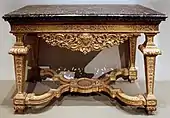 Baroque French pier table; 1685–1690; carved, gessoed, and gilded wood, with a marble top; 83.6 × 128.6 × 71.6 cm; Art Institute of Chicago (US)[48]
Baroque French pier table; 1685–1690; carved, gessoed, and gilded wood, with a marble top; 83.6 × 128.6 × 71.6 cm; Art Institute of Chicago (US)[48]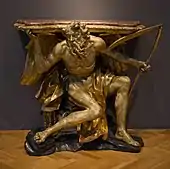 Baroque console table depicting Chronos, or the father time; 1695; painted and gilded wood, with marble at its top; overall: 95.3 x 107.3 x 62.9 cm; Cleveland Museum of Art
Baroque console table depicting Chronos, or the father time; 1695; painted and gilded wood, with marble at its top; overall: 95.3 x 107.3 x 62.9 cm; Cleveland Museum of Art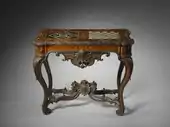
 Rococo French commode; by Gilles Joubert; circa 1735; oak and walnut, veneered with tulipwood, ebony, holly, other woods, gilt bronze and imitation marble; Museum of Fine Arts (Boston, USA)
Rococo French commode; by Gilles Joubert; circa 1735; oak and walnut, veneered with tulipwood, ebony, holly, other woods, gilt bronze and imitation marble; Museum of Fine Arts (Boston, USA)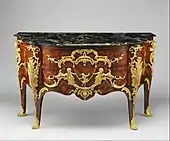 Rocaille Parisian commode; 1745-1749; pine and oak veneered with amaranth and bois satiné, walnut, gilt-bronze mounts, and portoro marble top; 87.6 x 139.7 x 57.8 cm; Metropolitan Museum of Art (New York City)
Rocaille Parisian commode; 1745-1749; pine and oak veneered with amaranth and bois satiné, walnut, gilt-bronze mounts, and portoro marble top; 87.6 x 139.7 x 57.8 cm; Metropolitan Museum of Art (New York City)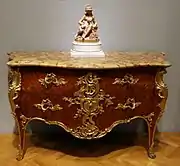 Rococo French chest of drawers; circa 1750; oak, tulipwood marquetry, gilt metal mounts and marble; overall: 88 x 156.5 x 69.9 cm; Cleveland Museum of Art
Rococo French chest of drawers; circa 1750; oak, tulipwood marquetry, gilt metal mounts and marble; overall: 88 x 156.5 x 69.9 cm; Cleveland Museum of Art_MET_DP106642.jpg.webp) Rococo German armchair; circa 1750–1760; carved and gilded beech, covered in blue damask not original to the armchair; Metropolitan Museum of Art (New York City)
Rococo German armchair; circa 1750–1760; carved and gilded beech, covered in blue damask not original to the armchair; Metropolitan Museum of Art (New York City)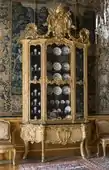 Rococo cabinet; 1770s; gilded walnut wood; height: 373 cm, width: 190 cm, depth: 67.5 cm; Hallwyl Museum (Stockholm, Sweden)
Rococo cabinet; 1770s; gilded walnut wood; height: 373 cm, width: 190 cm, depth: 67.5 cm; Hallwyl Museum (Stockholm, Sweden)_MET_DP105712.jpg.webp) Louis XVI drop-front desk (secrétaire à abattant or secrétaire en cabinet); circa 1776; oak veneered with tulipwood, amaranth, holly, and sycamore, six Sèvres soft-paste porcelain plaques and many other materials; 110.1 x 102.9 x 32.7 cm; Metropolitan Museum of Art
Louis XVI drop-front desk (secrétaire à abattant or secrétaire en cabinet); circa 1776; oak veneered with tulipwood, amaranth, holly, and sycamore, six Sèvres soft-paste porcelain plaques and many other materials; 110.1 x 102.9 x 32.7 cm; Metropolitan Museum of Art_MET_DP106952.jpg.webp) Louis XVI drop-front secretary (Secrétaire en armoire); 1783; oak veneered with ebony and 17th-century Japanese lacquer, gilt-bronze mounts, marble top and many other materials; overall: 144.8 × 109.2 × 40.6 cm; Metropolitan Museum of Art
Louis XVI drop-front secretary (Secrétaire en armoire); 1783; oak veneered with ebony and 17th-century Japanese lacquer, gilt-bronze mounts, marble top and many other materials; overall: 144.8 × 109.2 × 40.6 cm; Metropolitan Museum of Art_from_Louis_XVI's_Salon_des_Jeux_at_Saint_Cloud_MET_DP113960.jpg.webp) Louis XVI armchair (fauteuil) from Louis XVI's Salon des Jeux at Saint Cloud; 1788; carved and gilded walnut, gold brocaded silk (not original); overall: 100 × 74.9 × 65.1 cm; Metropolitan Museum of Art
Louis XVI armchair (fauteuil) from Louis XVI's Salon des Jeux at Saint Cloud; 1788; carved and gilded walnut, gold brocaded silk (not original); overall: 100 × 74.9 × 65.1 cm; Metropolitan Museum of Art
19th century
The nineteenth century is usually defined by concurrent revival styles, including Gothic, Neoclassicism, and Rococo. The design reforms of the late century introduced the Aesthetic movement and the Arts and Crafts movement. Art Nouveau was influenced by both of these movements.
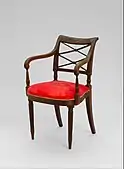 Armchair; by Duncan Phyfe; 1805–1815; mahogany; 84.1 x 51.8 x 42.5 cm; Metropolitan Museum of Art (New York City)
Armchair; by Duncan Phyfe; 1805–1815; mahogany; 84.1 x 51.8 x 42.5 cm; Metropolitan Museum of Art (New York City)_MET_DP278961.jpg.webp) French Empire desk chair; circa 1805-1808; mahogany, gilt bronze and satin-velvet upholstery; 87.6 × 59.7 × 64.8 cm; Metropolitan Museum of Art
French Empire desk chair; circa 1805-1808; mahogany, gilt bronze and satin-velvet upholstery; 87.6 × 59.7 × 64.8 cm; Metropolitan Museum of Art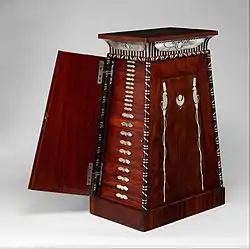 Egyptian revival coin cabinet; 1809-1819; mahogany (probably Swietenia mahagoni), with applied and inlaid silver; 90.2 x 50.2 x 37.5 cm; Metropolitan Museum of Art
Egyptian revival coin cabinet; 1809-1819; mahogany (probably Swietenia mahagoni), with applied and inlaid silver; 90.2 x 50.2 x 37.5 cm; Metropolitan Museum of Art
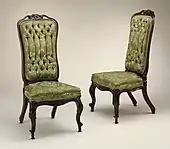 Pair of Rococo Revival slipper chairs; 1840-1860; rosewood, original silk damask upholstery; 95.25 x 45.72 x 48.26 cm (each); Los Angeles County Museum of Art (USA)
Pair of Rococo Revival slipper chairs; 1840-1860; rosewood, original silk damask upholstery; 95.25 x 45.72 x 48.26 cm (each); Los Angeles County Museum of Art (USA)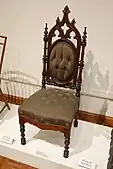 Gothic Revival chair; 1845-1865; walnut frame with upholstered seat and back; Huntington Museum of Art (Huntington, West Virginia, USA)
Gothic Revival chair; 1845-1865; walnut frame with upholstered seat and back; Huntington Museum of Art (Huntington, West Virginia, USA) Tête-à-tête, an example of Second Empire furniture; 1850-1860; rosewood, ash, pine and walnut; 113 x 132.1 x 109.2 cm; Metropolitan Museum of Art
Tête-à-tête, an example of Second Empire furniture; 1850-1860; rosewood, ash, pine and walnut; 113 x 132.1 x 109.2 cm; Metropolitan Museum of Art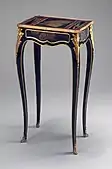 Small French table; circa 1880; wood, ormolu and lacquer; 68.9 x 26.99 x 38.42 cm; Los Angeles County Museum of Art
Small French table; circa 1880; wood, ormolu and lacquer; 68.9 x 26.99 x 38.42 cm; Los Angeles County Museum of Art.jpg.webp) Art Nouveau chair; by Arthur Heygate Mackmurdo; circa 1883; mahogany; 97.79 x 49.53 x 49.53 cm; Los Angeles County Museum of Art
Art Nouveau chair; by Arthur Heygate Mackmurdo; circa 1883; mahogany; 97.79 x 49.53 x 49.53 cm; Los Angeles County Museum of Art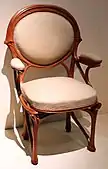
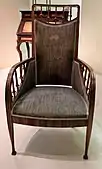 Art nouveau armchair; by Louis Majorelle; 1898; Musée d'Orsay
Art nouveau armchair; by Louis Majorelle; 1898; Musée d'Orsay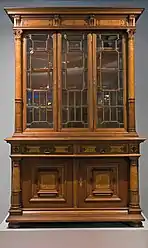 Buffet decorated with a pair of Corinthian columns; 1899; walnut, ash, beech, glass and metal; Historical Museum of Frankfurt (Germany)
Buffet decorated with a pair of Corinthian columns; 1899; walnut, ash, beech, glass and metal; Historical Museum of Frankfurt (Germany)
Early North American
This design was in many ways rooted in necessity and emphasizes both form and materials. Early British Colonial American chairs and tables are often constructed with turned spindles and chair backs often constructed with steaming to bend the wood. Wood choices tend to be deciduous hardwoods with a particular emphasis on the wood of edible or fruit bearing trees such as cherry or walnut.
Modernism
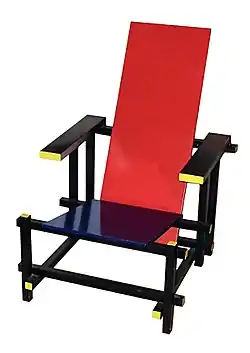
The first three-quarters of the twentieth century is often seen as the march towards Modernism. Art Deco, De Stijl, Bauhaus, Jugendstil, Wiener Werkstätte, and Vienna Secession designers all worked to some degree within the Modernist idiom. Born from the Bauhaus and Art Deco/Streamline styles came the post WWII "Mid-Century Modern" style using materials developed during the war including laminated plywood, plastics, and fiberglass. Prime examples include furniture designed by George Nelson Associates, Charles and Ray Eames, Paul McCobb, Florence Knoll, Harry Bertoia, Eero Saarinen, Harvey Probber, Vladamir Kagan and Danish modern designers including Finn Juhl and Arne Jacobsen. Postmodern design, intersecting the Pop art movement, gained steam in the 1960s and 70s, promoted in the 80s by groups such as the Italy-based Memphis movement. Transitional furniture is intended to fill a place between Traditional and Modern tastes.
Ecodesign
Great efforts from individuals, governments, and companies has led to the manufacturing of products with higher sustainability known as Ecodesign. This new line of furniture is based on environmentally friendly design. Its use and popularity are increasing each year.[49]
Contemporary
One unique outgrowth of post-modern furniture design is Live edge, heralding a return to natural shapes and textures within the home.[1]
Asian history
Asian furniture has a quite distinct history. The traditions out of India, China, Korea, Pakistan, Indonesia (Bali and Java) and Japan are some of the best known, but places such as Mongolia, and the countries of South East Asia have unique facets of their own.
Far Eastern
%252C_other_Asian_woods%252C_ivory_-_Peabody_Essex_Museum_-_DSC07355.jpg.webp)
The use of uncarved wood and bamboo and the use of heavy lacquers are well known Chinese styles. It is worth noting that Chinese furniture varies dramatically from one dynasty to the next. Chinese ornamentation is highly inspired by paintings, including: bamboo trees, chrysanthemums, waterlilies, irises, magnolias, flowers and branches of cherry, apple, apricot and plum, or elongated bamboo leaves. Animal ornaments include: lions, bulls, ducks, peacocks, parrots, pheasants, roosters, ibises and butterflies. The dragon is the symbol of earth fertility, and of the power and wisdom of the emperor. Lacquers are mostly populated with princesses, various chinese people, soldiers, children, ritually and daily scenes. Architecture has brought geometric ornaments, like meanders and labyrinths. The interior of a chinese house was simple and sober. All Chinese furniture is made of wood. The used species are: ebony, teak, rosewood for heavier furniture (chairs, tables and benches) bamboo, pine and larch for lighter furniture (stools and small chairs).[50]
Traditional Japanese furniture is well known for its minimalist style, extensive use of wood, high-quality craftsmanship and reliance on wood grain instead of painting or thick lacquer. Japanese chests are known as Tansu, known for elaborate decorative iron work, and are some of the most sought-after of Japanese antiques. The antiques available generally date back to the Tokugawa and Meiji periods. Both the technique of lacquering and the lacquer (resin of Rhus vernicifera) originate from China. Rhus vernicifera grows very well in Japan too. The recipes of preparation are original Japanese: resin is mixed with wheat flower, clay or pottery powder, turpentine, iron powder or wood coal. In ornamentation, the chrysanthemum, known as kiku, the national flower, is a very loved ornament. When it has 16 petals, it is the imperial symbol. Cherry and apple flowers are used for decorating screens, vases and shōjis. Animal ornaments include: dragons, carps, cranes, gooses, tigers, horses and monkeys. Architectural elements are also present: houses, pavilions, towers, torii gates, bridges and temples. The furniture of a Japanese house consists of tables, shelves, wardrobes, small holders for flowers, bonsais or for bonkei, boxes, lanterns with wooden frames and translucent paper, neck and elbow holders, and jardinieres.[51]
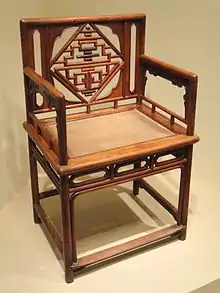 Chinese low-back armchair; late 16th-18th century (late Ming dynasty to Qing dynasty); huanghuali rosewood; Arthur M. Sackler Gallery (Washington D.C.)
Chinese low-back armchair; late 16th-18th century (late Ming dynasty to Qing dynasty); huanghuali rosewood; Arthur M. Sackler Gallery (Washington D.C.)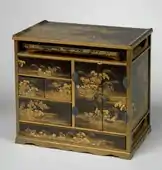 Japanese incense guessing game; 1615–1868; lacquer; overall: 23 x 25.4 x 16.6 cm; Cleveland Museum of Art (Cleveland, Ohio, US)
Japanese incense guessing game; 1615–1868; lacquer; overall: 23 x 25.4 x 16.6 cm; Cleveland Museum of Art (Cleveland, Ohio, US)%252C_brass_fittings_-_Portland_Art_Museum_-_Portland%252C_Oregon_-_DSC08449.jpg.webp) Chinese pedestal desk; 1644-1911; huanghuali wood (yellow flowering pear) with brass fittings; Portland Art Museum (Portland, Oregon, SUA)
Chinese pedestal desk; 1644-1911; huanghuali wood (yellow flowering pear) with brass fittings; Portland Art Museum (Portland, Oregon, SUA)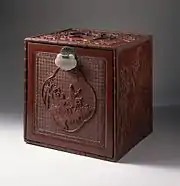 Japanese chest with cartouche showing figures on donkeys in a landscape; 1750-1800; carved red lacquer on wood core with metal fittings and jade lock; 30.64 x 30.16 x 12.7 cm; Los Angeles County Museum of Art (USA)
Japanese chest with cartouche showing figures on donkeys in a landscape; 1750-1800; carved red lacquer on wood core with metal fittings and jade lock; 30.64 x 30.16 x 12.7 cm; Los Angeles County Museum of Art (USA) Japanese tiered food Box with stand; late 18th century; red lacquer over a wood core, with litharge painting and engraved gold designs; overall: 53 x 68 cm; Cleveland Museum of Art
Japanese tiered food Box with stand; late 18th century; red lacquer over a wood core, with litharge painting and engraved gold designs; overall: 53 x 68 cm; Cleveland Museum of Art%252C_other_Asian_woods%252C_ivory_-_Peabody_Essex_Museum_-_DSC07353.jpg.webp) Chinese moon-gate bed; circa 1876; satinwood (huang lu), other Asian woods and ivory; Peabody Essex Museum (Salem, Massachusetts, USA)
Chinese moon-gate bed; circa 1876; satinwood (huang lu), other Asian woods and ivory; Peabody Essex Museum (Salem, Massachusetts, USA) Chinese canopy bed; late 19th or early 20th century; carved lacquered and gilded wood; Montreal Museum of Fine Arts (Montreal, Canada)
Chinese canopy bed; late 19th or early 20th century; carved lacquered and gilded wood; Montreal Museum of Fine Arts (Montreal, Canada)_and_Writing_Table_(Bundai)_with_Pines_at_Takasago_and_Sumiyoshi_MET_DP330034.jpg.webp) Japanese writing table; early 20th century; lacquered wood with silver fittings and various other materials; height: 12.3 cm, length: 60.96 cm, width: 36.83 cm; Metropolitan Museum of Art (New York City)
Japanese writing table; early 20th century; lacquered wood with silver fittings and various other materials; height: 12.3 cm, length: 60.96 cm, width: 36.83 cm; Metropolitan Museum of Art (New York City)
Types
For sitting
Seating is amongst the oldest known furniture types, and authors including Encyclopædia Britannica regard it as the most important.[2] In additional to the functional design, seating has had an important decorative element from ancient times to the present day. This includes carved and sculpted pieces intended as works of art, as well as the styling of seats to indicate social importance, with senior figures or leaders granted the use of specially designed seats.[2]
The simplest form of seat is the chair,[52] which is a piece of furniture designed to allow a single person to sit down, which has a back and legs, as well as a platform for sitting.[53] Chairs often feature cushions made from various fabrics.[54]
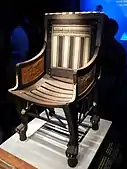 Ancient Egyptian armchair of Tutankhamun; 1336-1326 BC; wood, ebony, ivory and gold leaf; height: 71 cm; Exposition of Tutankhamun Treasure in Paris (2019)
Ancient Egyptian armchair of Tutankhamun; 1336-1326 BC; wood, ebony, ivory and gold leaf; height: 71 cm; Exposition of Tutankhamun Treasure in Paris (2019)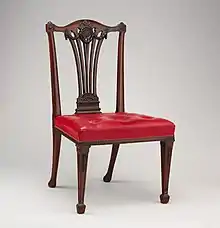 Neoclassical chair; circa 1772; mahogany, covered in modern red Morocco leather; height: 97.2 cm; Metropolitan Museum of Art (New York City)
Neoclassical chair; circa 1772; mahogany, covered in modern red Morocco leather; height: 97.2 cm; Metropolitan Museum of Art (New York City)_(one_of_a_pair)_MET_DP106762.jpg.webp) Louis XVI armchair (Fauteuil à la reine); 1780-1785; carved and gilded walnut, and embroidered silk satin; height: 102.2 cm, width: 74.9 cm, depth: 77.8 cm; Metropolitan Museum of Art
Louis XVI armchair (Fauteuil à la reine); 1780-1785; carved and gilded walnut, and embroidered silk satin; height: 102.2 cm, width: 74.9 cm, depth: 77.8 cm; Metropolitan Museum of Art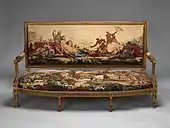 Louis XVI settee; designed in circa 1786, woven 1790–91, settee frame from the second half 19th century; carved and gilded wood, with wool and silk; 107.3 × 191.5 × 71.1 cm; Metropolitan Museum of Art
Louis XVI settee; designed in circa 1786, woven 1790–91, settee frame from the second half 19th century; carved and gilded wood, with wool and silk; 107.3 × 191.5 × 71.1 cm; Metropolitan Museum of Art
Types of wood used
All different types of woods have unique signature marks that can help in easy identification of the type. Both hardwoods and softwoods are used in furniture manufacturing, and each has their own specific uses.[55] Most commonly, quality furniture is made out of hardwood which is made from oak, maple, mahogany, teak, walnut, cherry and birch. Highest quality wood will have been air dried to rid it of its moisture.[56]
Standards for design, functionality and safety
_-_BEIC_6356404.jpg.webp)
- EN 527 Office furniture – Work tables and desks
- EN 1335 Office furniture – Office work chair
- ANSI/BIFMA X 5.1 Office Seating
- DIN 4551 Office furniture; revolving office chair with adjustable back with or without arm rests, adjustable in height
- EN 581 Outdoor furniture – Seating and tables for camping, domestic and contract use
- EN 1728:2014 Furniture – Seating – Test methods for the determination of strength and durability– updated in 2014.[57]
- EN 1730:2012 Furniture – Test methods for the determination of stability, strength and durability.
- BS 4875 Furniture. Strength and stability of furniture. Methods for determination of stability of non-domestic storage furniture (British Standard)
- EN 747 Furniture – Bunk beds and high beds – Test methods for the determination of stability, strength and durability
- EN 13150 Workbenches for laboratories – Safety requirements and test methods
- EN 1729 Educational furniture, chairs and tables for educational institutions[58]
- RAL-GZ 430 Furniture standard from Germany
- NEN 1812 Furniture standard from the Netherlands
- GB 28007-2011 Children's furniture – General technical requirements for children's furniture designed and manufactured for children between 3 and 14 years old
- BS 5852: 2006 Methods of test for assessment of the ignitability of upholstered seating by smouldering and flaming ignition sources
- BS 7176: Specification for resistance to ignition of upholstered furniture for non-domestic seating by testing composites
See also
- Casters which make some furniture moveable
- Furniture designer
- Metal furniture
Notes
- Gray, Channing. "Haute and cool: Fine Furnishings show branches out in 10th year with a bigger spread of classic and cutting-edge pieces". The Providence Journal.
- "Furniture". Encyclopædia Britannica. 23 February 2016. Archived from the original on 16 May 2016. Retrieved 16 May 2016.
- "English Translation of "fournir"". Collins French-English Dictionary.
- "English Translation of "fourniture"". Collins French-English Dictionary.
- Weekley 2013, pp. 609–610.
- Solodow 2010, p. 146.
- Smardzewski 2015, p. 4.
- Smardzewski 2015, p. 1.
- Smardzewski 2015, p. 2.
- Roebuck 1966, p. 51.
- Redford, Donald B. Egypt, Canaan, and Israel in Ancient Times. (Princeton: University Press, 1992), p. 6.
- Roebuck 1966, p. 52.
- Metropolitan Museum of Art 1999, p. 117.
- Blakemore 2006, p. 1.
- Blakemore 2006, p. 14.
- Gadalla 2007, p. 243.
- Smardzewski 2015, pp. 13–14.
- Smardzewski 2015, p. 14.
- Blakemore 2006, p. 15.
- Litchfield 2011, p. 6.
- Litchfield 2011, pp. 6–7.
- Blakemore 2006, p. 17.
- Blakemore 2006, p. 21.
- Blakemore 2006, p. 22.
- Blakemore 2006, p. 24.
- Blakemore 2006, p. 39.
- Richter 1966, p. 125.
- Richter 1966, p. 13.
- Richter 1966, pp. 14; NH 5.11.2ff.
- Linda Maria Gigante, “Funerary Art,” in The Oxford Encyclopedia of Ancient Greece and Rome, Vol. 1, ed. Michael Gagarin and Elaine Fantham (Oxford: Oxford University Press, 2010), 246.
- Guhl, E.; Koner, W. (1989). Everyday Life in Greek and Roman Times. New York: Crescent. p. 133.
- Wanscher 1980, p. 83.
- Simpson, 253.
- Blakemore 2006, p. 43.
- Andrianou, 36.
- Richter 1966, p. 63.
- Blakemore 2006, p. 42.
- Richter 1966, p. 66.
- Chicago Painter. "Stamnos (Mixing Jar)". Art Institute of Chicago.
- Blakemore 2006, p. 61.
- Lucie-Smith 1979, p. 33.
- Lucie-Smith 1979, p. 35.
- Bucătaru 1991, p. 172.
- Bucătaru 1991, p. 174.
- Bucătaru 1991, pp. 206, 207, 209, 210 & 211.
- unknown (18 September 2013) [before 1923]. A history of feminine fashion. Nabu Press. p. 71. ISBN 978-1-289-62694-5.
- Litchfield 2011, p. 211.
- "Pier Table". Art Institute of Chicago.
- "Ecodesign Report – The Results of a survey Amongst Australian Industrial Design Consultancies". Big's Furniture. Archived from the original on 19 February 2018. Retrieved 31 January 2017.
- Bucătaru 1991, pp. 152, 153, 154 & 156.
- Bucătaru 1991, p. 164, 165 & 166.
- "Physique of office chair". Foss Alborg. 15 August 2016. Retrieved 8 September 2016.
- "Definition of CHAIR".
- Jefferys, Chris (1 October 2006). Soft Furnishings. New Holland Publishers. ISBN 978-1-84330-903-1 – via Google Books.
- "Types of Wood". Hoove Designs. Retrieved 11 December 2011.
- Abbas, Abe. "Judge Quality in Wood Furniture". About.com. Retrieved 9 May 2015.
- "DIN EN 1728 – Furniture – Seating – Test methods for the determination of strength and durability; German version EN 1728:2012 – Engineering360".
- BS EN 1729 Chair and Table Guide
References
- Blakemore, Robbie G. (2006). History of interior design & furniture: from ancient Egypt to nineteenth-century Europe. J. Wiley & Sons. ISBN 978-0-471-46433-4.
- Bucătaru, Marina (1991). Stiluri și Ornamente la Mobilier (in Romanian). Editura Didactică și Pedagogică. ISBN 973-30-1079-0.
- Gadalla, Moustafa (2007). The Ancient Egyptian Culture Revealed. Tehuti Research Foundation. ISBN 978-1-931446-27-3.
- Litchfield, Frederick (2011). Illustrated History of Furniture. Arcturus Publishing. ISBN 978-1-84837-803-2.
- Lucie-Smith, Edward (1979). Furniture: A Concise History. Thames and Hudson. ISBN 978-0-500-18173-7.
- Metropolitan Museum of Art (1999). Egyptian Art in the Age of the Pyramids. New York: Metropolitan Museum of Art. ISBN 978-0-87099-907-9.
- Richter, G.M.A. (1966). The Furniture of the Greeks, Etruscans, and Romans. Phaidon.
- Roebuck, Carl (1966). The World of Ancient Times. New York: Charles Schribner's Sons Publishing.
- Smardzewski, Jerzy (2015). Furniture Design. Springer. ISBN 978-3-319-19533-9.
- Solodow, Joseph B. (2010). Latin Alive: The Survival of Latin in English and the Romance Languages. Cambridge University Press. ISBN 978-1-139-48471-8.
- Weekley, Ernest (2013). An Etymological Dictionary of Modern English. Courier Corporation. ISBN 978-0-486-12287-8.
- Wanscher, Ole (1980). Sella Curulis: The Folding Stool, an Ancient Symbol of Dignity. Copenhagen: Rosenkilde and Bagger.
External links
| Wikiquote has quotations related to: Furniture |
| Wikimedia Commons has media related to Furniture. |
- Images of online furniture design available from the Visual Arts Data Service (VADS) – including images from the Design Council Slide Collection.
- History of Furniture Timeline From Maltwood Art Museum and Gallery, University of Victoria
- Illustrated History Of Furniture
- Home Economics Archive: Tradition, Research, History (HEARTH)
An e-book collection of over 1,000 books on home economics spanning 1850 to 1950, created by Cornell University's Mann Library. Includes several hundred works on furniture and interior design in this period, itemized in a specific bibliography. - American Furniture in The Metropolitan Museum of Art, a fully digitized 2 volume exhibition catalog
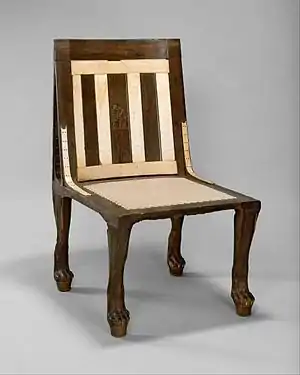

_MET_DP108870.jpg.webp)
_e_carlo_chivasse%252C_sedia%252C_torino_1835_ca.jpg.webp)
